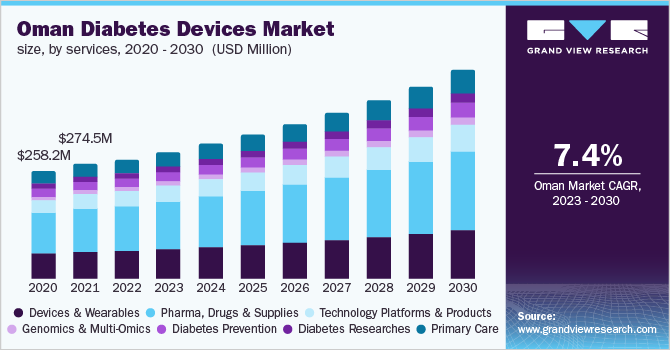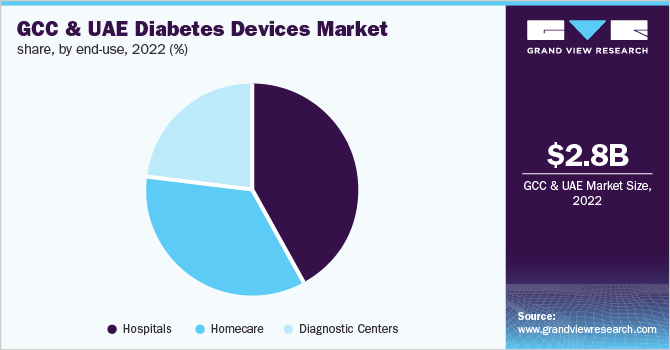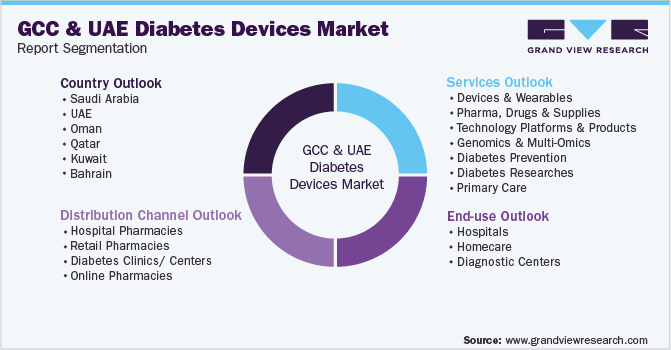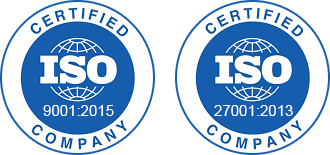- Home
- »
- Medical Devices
- »
-
GCC And UAE Diabetes Devices Market Share Report, 2030GVR Report cover
![GCC And UAE Diabetes Devices Market Size, Share & Trends Report]()
GCC And UAE Diabetes Devices Market Size, Share & Trends Analysis Report By Services (Devices And Wearables, Diabetes Prevention, Diabetes Researches), By Distribution Channel, By End-use, By Region, And Segment Forecasts, 2023 - 2030
- Report ID: GVR-4-68040-019-0
- Number of Report Pages: 100
- Format: PDF, Horizon Databook
- Historical Range: 2018 - 2021
- Forecast Period: 2023 - 2030
- Industry: Healthcare
Report Overview
The GCC and UAE diabetes devices market size was valued at USD 2.76 billion in 2022 and is expected to expand at a compound annual growth rate (CAGR) of 7.1% from 2023 to 2030. Key factors contributing to market growth include the rising incidences of diabetes, the growing adoption of advanced technology to treat & manage fluctuating blood glucose levels, and the increasing adoption of telehealth services during the COVID-19 pandemic. The market is further driven by growing awareness about diabetes preventive care, and government initiatives. Saudi Arabia’s government set a goal of achieving a 0% rise in diabetes-related mortality by 2025 and a 10% reduction in overall diabetes incidences by 2030. It has launched diabetes awareness initiatives and is actively promoting awareness regarding diabetes, which encourages healthcare practitioners to continue screening and early intervention efforts, including lifestyle changes.

Diabetes is a rapidly growing disease, which affects a large population in the Middle Eastern region, owing to an increase in unhealthy lifestyles and other associated risk factors. According to the International Diabetes Federation, in UAE the number of people suffering from diabetes is expected to reach 1.32 million in 2045 from 0.99 million in 2021. This disease prevalence can be prevented at an individual level by adopting healthier lifestyles and growing government initiatives.
For instance, in 2020, The Ministry of Health and Prevention (MoHAP) launched a drive-in awareness-raising project aimed at improving the quality of life of people suffering from diabetes and their ability to live with the disease. The Diabetes Prevention Program was also launched to provide information and training on diabetes-related healthy habits.
Gulf Cooperation Council countries have some of the world's highest diabetic prevalence rates. Over the past few decades, diabetes-related research activity has been observed to be low in this region. However, an increase in research funding and collaborations between local & international researchers and institutes are expected to boost the market growth.
The COVID-19 pandemic positively impacted the GCC & UAE diabetes market. Management of blood glucose levels became a critical task for patients admitted to hospitals with severe lung infections. Medications used to treat the disease led to significant changes in the patient blood glucose levels. Moreover, people living with diabetes with COVID-19 conditions were strictly admitted to critical care. Hence, the need for using diabetes monitoring devices significantly increased.
Services Insights
The pharma, drugs & supplies segment held the largest market share of 39.29% in 2022 in the services segment. It is expected to grow at the fastest CAGR during the forecast period. The rising prevalence of diabetes, increasing diabetes-related healthcare expenditure, and ongoing researches are key factors driving the market growth. Furthermore, the growing demand for efficient medication therapies for diabetes treatment is also expected to propel segment growth over the forecast period.
For instance, in February 2022, researchers at NYU Abu Dhabi, within the Trabolsi Research Group, developed an oral insulin delivery system that could eventually replace traditional insulin injections. The technology platforms and products segment is also anticipated to witness lucrative growth during the forecast period. Various innovative and developing technologies continue to converge to influence the digital health trajectory for the prevention of diabetes. Patients & healthcare providers continue to adopt various technologies. These include connected glucose meters, continuous subcutaneous insulin infusion, CGM systems, closed-loop systems, digitalization of health data, and diabetes-related applications. These new technologies are transforming healthcare delivery.
Distribution Channel Insights
Based on the distribution channel, the market is segmented into hospital pharmacies, retail pharmacies, diabetes clinics/centers, online pharmacies, and others. The hospital segment captured the largest market share in 2022. Hospitals consist of inpatient and outpatient pharmacies. The primary role of a hospital inpatient pharmacy is to supply medicines and medical equipment to several departments in need.
Stringent glucose monitoring is vital in diabetes patients in ICU, undergoing cardiothoracic surgery and insulin therapy, which is expected to drive the demand for diabetes devices. The online pharmacies segment is expected to witness the fastest CAGR of 7.5% during the forecast period. As online pharmacies directly procure diabetes devices from manufacturers, it helps them avail lucrative deals for customers. The increasing patient awareness about online pharmacies and increased public-private funding are key factors driving the segment.
End-Use Insights
In 2022, the hospital segment dominated the GCC and UAE diabetes devices market with a share of 42.29%. Diabetes technology has evolved rapidly in the past few years. Most of these technologies aim to improve diabetes care in hospitals and clinics. These advancements in technology have increased the usage of insulin pumps in hospitals. Furthermore, the increasing number of hospital admissions for diabetes patients continues to boost the demand for the segment.

The homecare segment is anticipated to witness a significant CAGR over the forecast period. Increasing government initiatives to promote awareness about diabetes and the user-friendly interface of insulin pumps are increasing the demand for insulin pumps in homecare settings. Moreover, the increasing geriatric population also continues to boost the demand for homecare. According to WHO, 80% of the total elder population are living in low- and middle-income countries. By 2050, the total population aged 60 and older is expected to reach 2 billion.
Country Insights
Saudi Arabia dominated the market for GCC and UAE diabetes devices and accounted for the largest revenue share of 28.64 % in 2022. Diabetes is a major health concern in Saudi Arabia. According to the International Diabetes Federation (IDF), approximately 4.27 million people were living with diabetes in 2021 in the country, which is expected to increase to 7.53 million by 2045. The total diabetes-related healthcare spending in the country was about USD 7,459.5 million in 2021, which is expected to increase to USD 10,045.2 million by 2045. Key drivers of the market include the increasing prevalence of diabetes and technological advancements.
UAE is estimated to showcase the fastest growth over the forecast period. Key drivers of the market include the high prevalence of diabetes, rapid adoption of innovative products, increasing R&D efforts, and growing awareness about diabetes preventive care. Several diabetes awareness programs and government initiatives are expected to contribute to market growth during the forecast period. For instance, in 2020, The Ministry of Health and Prevention (MoHAP) launched a drive-in awareness-raising project aimed at improving the quality of life of people suffering from diabetes and their ability to live with the disease.
Key Companies & Market Share Insights
Key players are implementing various strategies including partnerships through mergers and acquisitions, geographical expansions, product launches, government approvals, and strategic collaborations to expand their market presence. For instance, in August 2022, Abbott partnered with WW International, Inc. (WeightWatchers). Through this partnership, both companies will combine the weight management program of WeightWatchers for people with diabetes with Abbott's line of FreeStyle Libre products to produce a seamless mobile experience. It will offer knowledge & insights to improve their diet, lower their blood sugar levels, and ultimately help patients take back control of their health. Some prominent players in the GCC and UAE diabetes devices market include:
-
Medtronic
-
Abbot Laboratories
-
Ascensia Diabetes Care Holdings
-
Dexcom
-
F. Hoffmann- La Roche AG,
-
Sanofi
-
Novo Nordisk A/S
-
Insulet Corporation
-
Ypsomed AG
-
Eli Lily
-
Astra Zeneca
GCC And UAE Diabetes Devices Market Report Scope
Report Attribute
Details
Market size value in 2023
USD 2.92 billion
Revenue forecast in 2030
USD 4.72 billion
Growth rate
CAGR of 7.1% from 2023 to 2030
Base year for estimation
2022
Historical data
2018 - 2021
Forecast period
2023 - 2030
Quantitative units
Revenue in USD million/billion and CAGR from 2023 to 2030
Report coverage
Revenue forecast, company ranking, competitive landscape, growth factors, and trends
Segments covered
Services, distribution channel, end-use, country
Regional scope
Middle East
Country scope
Saudi Arabia; UAE; Oman; Qatar; Kuwait; Bahrain
Key companies profiled
Medtronic; Abbott Laboratories; Ascensia Diabetes Care Holdings; Dexcom; F. Hoffmann- La Roche AG, Sanofi; Novo Nordisk A/S; Insulet Corporation; Ypsomed AG, Eli Lily; Astra Zeneca
Customization scope
Free report customization (equivalent up to 8 analyst’s working days) with purchase. Addition or alteration to country, regional & segment scope
Pricing and purchase options
Avail customized purchase options to meet your exact research needs. Explore purchase options
GCC And UAE Diabetes Devices Market Segmentation
This report forecasts revenue growth at regional and country levels and provides an analysis of the latest industry trends in each of the sub-segments from 2018 to 2030. For this study, Grand View Research has segmented the GCC and UAE diabetes devices market report based on services, distribution channel, end-use, and country:

-
Services Outlook (Revenue, USD Million, 2018 - 2030)
-
Devices And Wearables
-
Pharma, Drugs & Supplies
-
Technology Platforms And Products
-
Genomics And Multi-Omics
-
Diabetes Prevention
-
Prediabetes Early Intervention
-
Early Diagnosis And Diabetes
-
Behavioral And Lifestyle Changes
-
-
Diabetes Researches
-
Primary Care
-
-
Distribution Channel Outlook (Revenue, USD Million, 2018 - 2030)
-
Hospital Pharmacies
-
Retail Pharmacies
-
Diabetes Clinics/ Centers
-
Online Pharmacies
-
-
End-Use Outlook (Revenue, USD Million, 2018 - 2030)
-
Hospitals
-
Homecare
-
Diagnostic Centers
-
-
Country Outlook (Revenue, USD Million, 2018 - 2030)
-
Saudi Arabia
-
UAE
-
Oman
-
Qatar
-
Kuwait
-
Bahrain
-
Frequently Asked Questions About This Report
b. The GCC and UAE diabetes devices market size was estimated at USD 2.76 billion in 2022 and is expected to reach USD 2.92 billion in 2023.
b. The GCC and UAE diabetes devices market is expected to grow at a compound annual growth rate of 7.1% from 2023 to 2030 to reach USD 4.72 billion by 2030.
b. Pharma, drugs and supplies dominated the GCC and UAE diabetes devices services market with a share of 39.29% in 2022. This is attributable to the growing demand for efficient medication therapies for diabetes treatment.
b. Some key players operating in the GCC and UAE diabetes devices market include Medtronic; Abbot Laboratories; Ascenia Diabetes Care Holdings; Dexcom; F. Hoffmann- La Roche AG, Sanofi; Novo Nordisk A/S; Insulet Corporation; Ypsomed AG, Eli Lily; and Astra Zeneca
b. Key factors that are driving the GCC and UAE diabetes devices market growth include rising incidence of diabetes, and growing adoption of advanced technology to treat & manage fluctuating blood glucose levels.
Share this report with your colleague or friend.
![gvr icn]()
NEED A CUSTOM REPORT?
We can customize every report - free of charge - including purchasing stand-alone sections or country-level reports, as well as offer affordable discounts for start-ups & universities. Contact us now
![Certified Icon]()
We are GDPR and CCPA compliant! Your transaction & personal information is safe and secure. For more details, please read our privacy policy.
We are committed towards customer satisfaction, and quality service.
"The quality of research they have done for us has been excellent."





